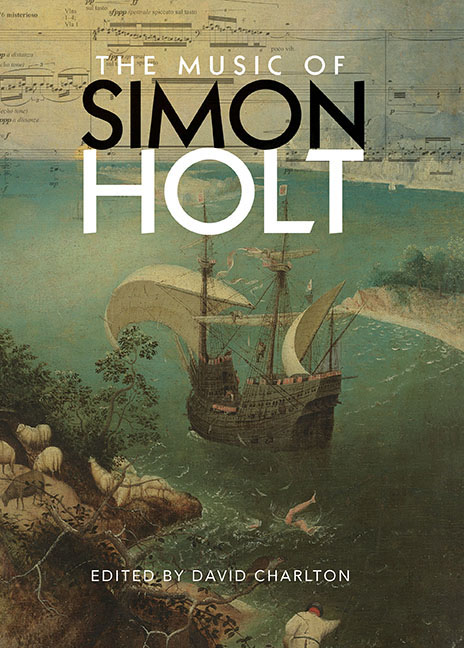Book contents
- Frontmatter
- Contents
- Figures and Tables
- Contributors
- Preface and Acknowledgements
- Abbreviations, with a note on recordings and scores
- Introduction Memories of Magical Moonlight: Simon Holt's years as a composition student
- 1 Duende y Duelos: The Andalusian spirit in the Lorca settings
- 2 An Interplay of Passion and Spirit: The Nightingale's to Blame
- 3 Images in Sound: Movement, harmony and colour in the early music
- 4 Myth and Narrative in 3 for Icarus
- 5 Sound, Sense and Syntax: The Emily Dickinson settings
- 6 Piano Music
- 7 Redefining the Cello's Voice: Musical agency in feet of clay
- 8 Performance and Reflections: Holt's music for oboe and cor anglais
- 9 Shaking the Bars: The Yellow Wallpaper
- 10 Listening to the River's Roar: Stance, texture and space in the concertos
- 11 Orchestral Works in Performance
- 12 Oblique Themes and Still Centres: A conversation between
- 13 Sketching and Idea-Gathering
- 14 Art, Conceptualism and Politics in Holt's music
- Appendix A Overview and Catalogue of Pieces
- Appendix B Texts by Simon Holt for Raju Raghuvanshi is a ghost and The Legend of Melusine
- Bibliography
- Index of pieces by Simon Holt
- General index
6 - Piano Music
Published online by Cambridge University Press: 01 September 2018
- Frontmatter
- Contents
- Figures and Tables
- Contributors
- Preface and Acknowledgements
- Abbreviations, with a note on recordings and scores
- Introduction Memories of Magical Moonlight: Simon Holt's years as a composition student
- 1 Duende y Duelos: The Andalusian spirit in the Lorca settings
- 2 An Interplay of Passion and Spirit: The Nightingale's to Blame
- 3 Images in Sound: Movement, harmony and colour in the early music
- 4 Myth and Narrative in 3 for Icarus
- 5 Sound, Sense and Syntax: The Emily Dickinson settings
- 6 Piano Music
- 7 Redefining the Cello's Voice: Musical agency in feet of clay
- 8 Performance and Reflections: Holt's music for oboe and cor anglais
- 9 Shaking the Bars: The Yellow Wallpaper
- 10 Listening to the River's Roar: Stance, texture and space in the concertos
- 11 Orchestral Works in Performance
- 12 Oblique Themes and Still Centres: A conversation between
- 13 Sketching and Idea-Gathering
- 14 Art, Conceptualism and Politics in Holt's music
- Appendix A Overview and Catalogue of Pieces
- Appendix B Texts by Simon Holt for Raju Raghuvanshi is a ghost and The Legend of Melusine
- Bibliography
- Index of pieces by Simon Holt
- General index
Summary
I FIRST CAME ACROSS Simon Holt's early Piano Piece (revised twenty years later as Black Lanterns) as a young and enthusiastic pianist, looking out scores and eager to explore the music of my own time. It was apparent from the facsimile score that here was the arrival of an exceptional and original voice. Even the notation delivered something fresh – where were the flats?! The music had attractive qualities. It spoke an unsentimental, modernist language. The jump-cuts of its montage-like form gave it a dramatic and visceral immediacy. Furthermore the pianist in me recognised the composer's feel for the sonority of the instrument and his sense of confidence in the writing for it. At times, virtuosic gestures seem to have been written to leap across the full range of the keyboard with something of the exhilarating aplomb which the young Boulez had brought to the piano in the first movement of his Sonata nº 1. But it was the compelling nature of the music that chimed deeply with me. The work seemed to have the same quality as found by Thomas Adès in the music of Janáček: ‘the sap of feeling is there in the music from the very beginning, and that is what drives it’. A performance of such music would require of the performer a rare combination of bravura with poetry, something which I found an irresistible challenge.
In what follows, an overview of Holt's piano writing is followed by notes specific to various pieces.
Holt's earliest extant work is for piano, composed while he was still a student at the Royal Northern College of Music. Written to fit on a postcard, a postcard piece (1979) was sent to his future teacher, Anthony Gilbert, to greet him on return from Australia (see Introduction). Holt has since produced a sizeable amount of work for solo piano, considerably more than can fit on a single CD. His ensemble works are centrally important, and those which include piano sometimes privilege it over the other instruments in ways which have structural outcomes as well as alluring colouristic ones. eco-pavan (H 29, 1998), whose sonorous interactions are extraordinary, is such a work, and the only one marked explicitly as being for piano solo and ensemble in the score.
- Type
- Chapter
- Information
- The Music of Simon Holt , pp. 128 - 144Publisher: Boydell & BrewerPrint publication year: 2017

